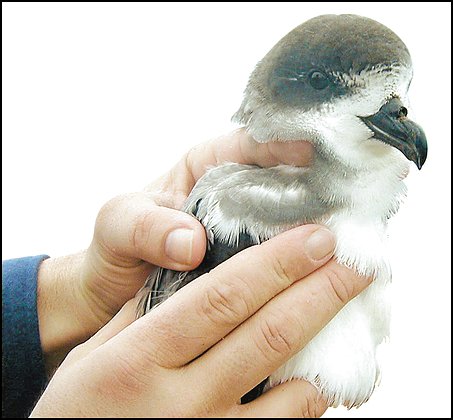|
| 질의: british birds | 결과: 170번째/534 | |
Bermuda Petrel (Pterodroma cahow) - Wiki
| 제목: | Bermuda Petrel (Pterodroma cahow) - Wiki
| |

| 해상도: 453x420
파일크기: 64022 Bytes
촬영일: 2003:11:07 14:53:00
등록시간: 2007:12:13 14:30:04
|
Bermuda Petrel
From Wikipedia, the free encyclopedia
Order: Procellariiformes
Family: Procellariidae
[Photo] Bermuda Petrel (Pterodroma cahow). Bermuda Government photo. Source: http://en.wikipedia.org/wiki/Image:Pterodroma_cahow.jpg | Permission is granted to copy, distribute and/or modify this document under the terms of the GNU Free Documentation License, Version 1.2 or any later version published by the Free Software Foundation; with no Invariant Sections, no Front-Cover Texts, and no Back-Cover Texts. A copy of the license is included in the section entitled "GNU Free Documentation License". |
The Bermuda Petrel Pterodroma cahow is a gadfly petrel.
Commonly known in Bermuda as the Cahow, a name derived from its eerie cries, this nocturnal ground-nesting seabird is the national bird of Bermuda, and a symbol of hope for nature conservation. It was thought extinct for 330 years. Its dramatic rediscovery as a "Lazarus species", that is, a species found to be alive after being considered extinct for centuries, has inspired documentary filmmakers.
Initially superabundant throughout the archipelago, the Cahow is a slow breeder, but excellent flier, and spends its adult life on the open seas. At five years old it returns to its former nesting place and begins breeding, laying only one egg per season. Cahows mate for life.
The Cahows' eerie nocturnal cries stopped the early Spanish seafarers settling the Islands out of superstition, as they thought the Isles were inhabited by Devils. Instead they put ashore hogs as a living foodstore for passing ships, and so began the onslaught on the Cahow's existence. Following Bermuda's colonisation by the British, introduced species like rats, cats and dogs, and mass killings of the birds by early colonists decimated numbers. Despite being protected by one of the world's earliest conservation decrees, the Governor's proclamation "against the spoyle and havocke of the Cohowes," the birds were thought to have been driven to extinction since the 1620s.
In 1951, 18 surviving nesting pairs were found on rocky islets in Castle Harbour, and a program was set up by David B. Wingate to build concrete burrows and wooden bafflers for the nesting tunnels in order to keep out the slightly larger, competing 'Bermuda longtail', and to restore the nearby Nonsuch Island to be a future viable base for the species.
Enjoying legal protection, the species has started to make a good recovery, The main threat for the future is lack of suitable breeding habitat. Hurricane Fabian destroyed many nesting burrows in 2003, and recently the larger and ecologically-restored Nonsuch Island is being repopulated with chicks, their translocation timed so they will imprint on these surroundings. This work is being undertaken by the present Bermuda Conservation Officer Jeremy Madeiros assisted by the Australian petrel specialist Nick Carlile.
Nonetheless, the global population of this bird in 2005 was only about 250 individuals.
http://en.wikipedia.org/wiki/Bermuda_Petrel
| The text in this page is based on the copyrighted Wikipedia article shown in above URL. It is used under the GNU Free Documentation License. You may redistribute it, verbatim or modified, providing that you comply with the terms of the GFDL. |
|
^o^
동물그림창고 똑똑전화 누리집
^o^
|
|